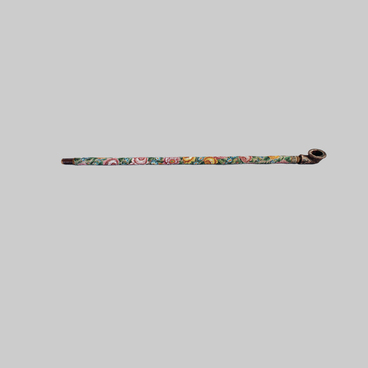In the family of the Decembrist MatvEy MuravyOv-ApOstol, the pupils were taught needlework. Avgusta Sozonovich, one of the foster children of the Decembrist, for some time was in charge of the needlework class at the girls’ school, opened by the Decembrist Ivan Yakushkin in YalUtorovsk. Craftswomen improved their craft: some used special aids with patterns and ideas, sometimes composed embroidery plots themselves, and occasionally made copies of painting reproductions and turned them into embroidery. Handcrafts were often made of beads. In Russia, beadwork was mainly done by those of noble families. Hand embroidery made of beads could be so skillfully executed that such work was often presented to the Empress as a present.
The item depicted is the most widespread needlework set in the 19th century. It was made in Russia in the 19th century. The set for needlework consists of a case, a hook for lifting loops, a crochet hook, a case for needles, a knife and scissors. These devices allowed the girls to do any kind of handicraft: embroidery, crocheting, beading, and others. The cover of the case was folded back and closed with two fasteners. The body of the case is made of wood, the outside is pasted over with brown paper, the inside is sheathed with satin and light blue plush. The included hook for lifting the hinges consists of a rod and a handle. The rod is made of light gray metal, straight, with a sharp end. The handle of the hook was cut out of white bone, turned and decorated with carved belts and a spherical tip. The crochet hook was decorated in the same way. The needle case was made of a white, cylindrical bone, tapering slightly on one side. It consists of two parts connected by a screw thread.
It was also decorated with carved ball-shaped points. The knife is cut out of light gray metal, and its handle is made of white bone. Like other handicraft knives, the blade in this set is short, straight, and pointed. The kit was added to the museum collection in 1993. The museum staff bought it in an antique store in Moscow specifically for a new exhibit in the memorial house of M.I. Muravyov-Apostol. The house-museum was opened after restoration in 1994.
The item depicted is the most widespread needlework set in the 19th century. It was made in Russia in the 19th century. The set for needlework consists of a case, a hook for lifting loops, a crochet hook, a case for needles, a knife and scissors. These devices allowed the girls to do any kind of handicraft: embroidery, crocheting, beading, and others. The cover of the case was folded back and closed with two fasteners. The body of the case is made of wood, the outside is pasted over with brown paper, the inside is sheathed with satin and light blue plush. The included hook for lifting the hinges consists of a rod and a handle. The rod is made of light gray metal, straight, with a sharp end. The handle of the hook was cut out of white bone, turned and decorated with carved belts and a spherical tip. The crochet hook was decorated in the same way. The needle case was made of a white, cylindrical bone, tapering slightly on one side. It consists of two parts connected by a screw thread.
It was also decorated with carved ball-shaped points. The knife is cut out of light gray metal, and its handle is made of white bone. Like other handicraft knives, the blade in this set is short, straight, and pointed. The kit was added to the museum collection in 1993. The museum staff bought it in an antique store in Moscow specifically for a new exhibit in the memorial house of M.I. Muravyov-Apostol. The house-museum was opened after restoration in 1994.



